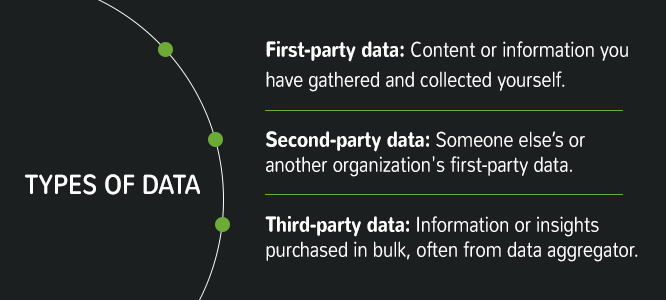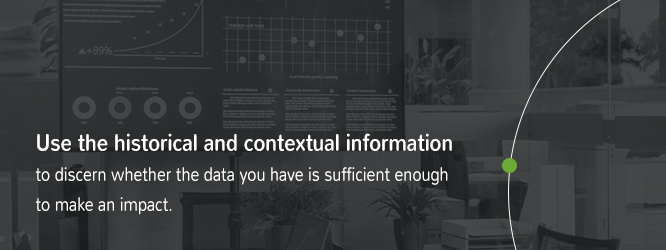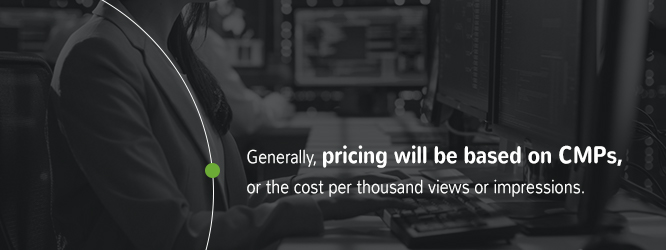Table of Contents
First vs. Second vs. Third Party Data
Is My 1st Party Data Sufficient?
How to Choose a 3rd Party Data Provider
In today’s digital landscape, data — or, more specifically, the right data — is crucial to the efficient and optimal operation of your business and its many processes.
You need data. For marketers, agencies and publishers who may be lacking first-party data to fulfill their data-driven campaigns, many rely on third-party data to help them meet their campaign goals. Knowing what kind of third-party data you should acquire, and accurately judging its quality is vital to the success of your marketing operations.
The following guide provides a comprehensive look at buying third-party data.
First- vs Second- vs Third-Party Data
Before we dive in, we need to define the difference between third-party data and other sources.
In basic terms, first-party data is content or information you have gathered and collected yourself. This is data that you own, and you know the source. It is often considered the most valuable and the highest quality, since you gathered it yourself.

See How Lotame Can Help You Today
Similarly, second-party data is someone else’s or another organization’s first-party data. You get second-party data directly from the source (the owner), so there are no questions of where it came from. This is often considered the next best thing, after first-party data.
Third-party data, on the other hand, includes information or insights purchased in bulk, often from data aggregator. The provider doesn’t explicitly have a connection or direct relationship with the customers it collects information from. There are many data providers selling many different types of data around the world.
Third-party data is much larger in scope than the other data types. The sheer volume of user data and information you gain access to makes it incredibly viable, in turn helping you become more competitive. You can use 3rd party data to reach new target audiences, better understand demographics outside your natural consumer base and even compete in new industries.
Third-party data is best suited for targeting that’s based on behavior, context and demographics. It has sweeping implications for the marketing-related information you manage.
Is My 1st Party Data Sufficient?
One of the best ways to measure your data is by scope. You must look at the impressions or engagements coming in and compare that to overall performance.
To make things a little simpler, we’ll lay out the following process for measuring data by scope:
- Determine the number of impressions you wish your campaign to deliver.
- Calculate the ratio of impressions to unique visits, or opportunities versus page views.
- Using historical data for a previously targeted audience, compare the number of impressions actually run to what your estimate was. This can be done by looking at unique impressions, opportunities and page views.
- Once an estimate is provided, you can determine whether or not the size of the audience in question should be increased. This will then inform whether or not you need third-party data.
In summary, use the historical and contextual information to discern whether the data you have is sufficient enough to make an impact. If you find that not to be the case, you’ll want to branch out and acquire third-party data to augment and expand your own.

An Example of Data Buying in the Real-World
Let’s take a look at this third-party data-buying process boiled down and applied to a real-world scenario.
Imagine receiving a request for proposal (RFP) from Versace. In this case, the RFP states it wants to appeal to mothers between the ages of 25 and 34, who they believe to be their target audience.
A few things can be done for this scenario:
- Marketers can jump in and create this exact audience segment — assuming enough data is already available on-hand for fans of Versace products — and look at this audience profile report for relevant interests and behaviors. This will allow them to measure and scale their efforts.
- To expand this niche audience, it could be better to look at fans of high-end clothing, or fans of general high fashion. This creates a multitude of options and market opportunities previously untapped. To target these fashion-lovers, the marketer could reach about 10,000 people for a CPM of $30.
- Expanding further, they can broaden their target using data and reach women aged 25 to 34 who like high-end clothing in general, reaching about one million leads at a price of $10 CPM.
- Or marketers can go even broader, targeting everyone interested in high-end women’s clothing and reaching five million leads at a price of $8 CPM.
- At its largest data application, marketers could target women aged 25 to 34 who like art or high-end fashion, reaching ten million prospects at $7 CPM. Data has shown that these users are four times more likely to be interested in brands like Versace than the average shopper, thus aligning with the initial proposal.
Looking at these options collectively, the most cost-efficient solution for the organization would be to target woman aged 25 to 34 who like art and fashion. It reaches the largest target audience at the most cost-effective CPM.
To come to that conclusion, however, requires optimization and knowledge of not just current processes, but more exact and creative demographics the company is looking to target.
How to Choose a 3rd Party Data Provider?
Now that you have determined you need to supplement your existing data with third-party data, the big question is where to go. With so many data providers out there, how do you know which one to choose? Obviously you are looking for high-quality, accurate information, but how can you judge that? Here are five factors you should always consider when buying third-party data:
Source
To understand the data you are considering, you’ll want to look at how each data provider collects information. What sources are they using and what methodology have they employed?
In most cases, a data provider is not collecting the information on their own. They are often acquiring data from a variety of sources or individual clients and then compiling the insights to provide more relevant content. Getting to the bottom of those data funnels is important. Where did it come from? Was it modeled or validated?

Scale
Next, you should consider scale, or the amount of data available once you gain provider access. This is important, because it decides how and where your business’ data use will grow in the future. If you are like many marketers looking for additional data to help them fulfill their campaign goals, you’ll have a target number in mind.
Reputation
You’ll want references to the work and reputation of your prospective provider. Does your primary choice have proven results to show? Whom have they worked with in the past? Are there any comparable brands or organizations like yours in their portfolio? Ask around and see who has had success working with the particular data provider you are working with.
Price

Another consideration for choosing a data provider is the cost they charge for access. In most cases, pricing will be based on CPMs, or the cost per thousand views or impressions, although there is quite a bit of discussion in the market recently about changing that price model. Each data segment is priced differently, and prices can vary from $1 to a little over a $50 per CPM depending on the provider.
Quality
The quality of data matters immensely. Not only the quality or accuracy of the data itself but also its value as it pertains to your business and goals.
Lotame’s Precision Audiences Platform Provides the Quality Data You Need
Lotame Precision Audiences are a new line of high-quality demographic data segments that have been specifically curated to reach their target audience above industry benchmarks for accuracy.
1. Validated
Through a series of proprietary “continually on” validation tests, Lotame ensures their data segments exceed industry benchmarks in regards to accuracy and precision. This means there’s never any question whether or not the data you are gaining access to is relevant to your business and goals — it already is.

When you use Precision Audiences segments, you can be absolutely confident you are reaching the appropriate and intended audience for your business.
2. Globally Scaled
Most data providers focus on a small demographic, audience or region when building information profiles and data segments. That is not the case with Lotame’s Precision Audiences.
In fact, their segments account for all major markets and global opportunities. This creates the opportunity for quality data across all audiences and demographics.
3. Proprietary
Not only is Lotame’s Precision Audience data curated and validated by industry experts, but it is also wholly proprietary and developed or handled in-house. You will not and cannot find anything else like it on the market.
Furthermore, Lotame doesn’t depend on another party to facilitate the platform and build data segments. It’s all handled by Lotame’s highly-regarded, in-house data team.
What Kind of Data Do You Need?
Are you choosing the right data provider? As this guide has hopefully shown, a better and more robust understanding of your business, operations and marketing goals is necessary to choose the right data source. In turn, this relates directly to selecting the appropriate data provider, because each one will have diverse sources, intel, and information.
This doesn’t exclude organization using only first and second-party data currently, either. Eventually, you may need to acquire additional resources and information, which would involve knowing how and where to find the necessary sources.
Make sure you understand why the right third-party data provider is crucial to your success and how to go about choosing one. It will only help in the long run — especially as you grow your consumer base. Request a demo today to see how Lotame can help you better connect with your customers.